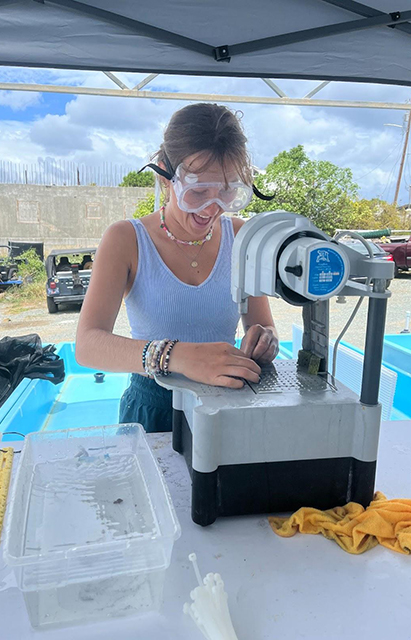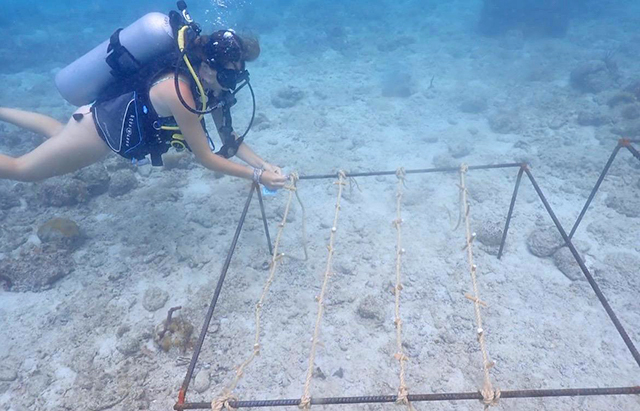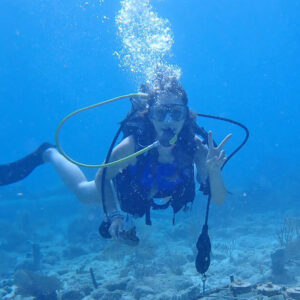
Maginnes learned how to cut coral micro-fragments to promote optimal growth while working at Coral World Ocean and Reef Initiative in St. Thomas, USVI.
For the better half of my life, I knew that I wanted to go into the field of marine biology. However, it wasn’t until my high school biology teacher decided to screen the documentary Chasing Coral, in lieu of our normal lecture, that I discovered exactly what my newfound passion would be. As the credits of the documentary rolled, I immediately grabbed my phone to text my older brother, who found a hobby in nagging me about not yet knowing what I wanted to do with my life. The text read, “I think I figured out what I am going to do when I grow up, I’m going to save the coral reefs.”
I soon went on to attend Duke University and realized that saving coral reefs from a landlocked school proved to be rather challenging. While I was incredibly fortunate to get to spend a semester on the coast at the Duke University Marine Lab and take part in a few smaller scale coral related research projects, I still yearned for more.
The culmination of my long-awaited dream to break into the field of coral restoration came when I was awarded NOAA’s Hollings Undergraduate Scholarship. With the Hollings program, I was lucky enough to participate in an internship revolving around coral disease response. I worked predominantly with Dana Wusinch-Mendez of NOAA’s Coral Reef Conservation Program and Caroline McLaughlin of Florida Sea Grant assisting with efforts of the US Coral Reef Task Force’s Coral Disease Working Group and its sub-committees. The sub-committee with which I was most prominently involved was the Pacific Preparedness Team. This is a group of individuals from the Atlantic, Caribbean, and Pacific, who meet to discuss recent knowledge about stony coral tissue loss disease (SCTLD) and intervention methods and resources.
My favorite part of the internship was seeing how people from different jurisdictions worked together and exchanged unique viewpoints, new discoveries and inventive ideas. It showed me that the only way we are going to be able to save reefs is as a united front.
Sophie Maginnes

Photo provided by Sophie Maginnes
The main goal of this committee is to ensure that Pacific jurisdictions are equipped with the knowledge and resources necessary if SCTLD were to reach their reefs. With this group, I helped create many communication materials and plan and execute multiple workshops. This included the Pacific Preparedness Workshop at the 45th U.S. Coral Reef Task Force (USCRTF) annual meeting in Kailua-Kona, Hawai ‘i, and a series of online workshops covering topics including disease intervention and funding. Furthermore, I carried out multiple individual projects for both NOAA and Florida Sea Grant, including a literature review of all current SCTLD treatment methods, as well as the creation of a database of governmental and private funding opportunities for coral disease response.
In addition to the work with the Task Force, I also assisted in field efforts in St. Thomas, U.S. Virgin Islands (USVI). Working part time with the non-profit Coral World Ocean and Reef Initiative, I gained ample experience in coral husbandry at both the land and water nurseries. I developed technical skills in disease identification and treatment, coral collection and outplanting methods, and the art of cutting the perfect coral micro-fragment to promote optimal growth.
Reflecting on my time as a Hollings scholar, I feel incredibly lucky to have experienced so many different facets of coral disease response within one internship. It was truly inspiring to witness firsthand all the ways in which people are coming together to help fight SCTLD and protect and restore coral. Arguably, my favorite part of the internship was seeing how people from different jurisdictions worked together and exchanged unique viewpoints, new discoveries, and inventive ideas. It showed me that the only way we are going to be able to save reefs is as a united front. I am now more invigorated than ever to continue pursuing 16-year-old Sophie’s dream to save the reefs, and I’m incredibly excited to see where this passion will lead me after graduation.
About The BLOGGER
 Sophie Maginnes is a senior at Duke University pursuing a B.S. in both environmental science and biology, with a concentration in marine science. Being awarded the NOAA Hollings Scholarship provided her the opportunity to live outside of her home state of North Carolina for the first time in her life! After graduation, Maginnes plans to pursue a divemaster certification and continue in the field of marine conservation.
Sophie Maginnes is a senior at Duke University pursuing a B.S. in both environmental science and biology, with a concentration in marine science. Being awarded the NOAA Hollings Scholarship provided her the opportunity to live outside of her home state of North Carolina for the first time in her life! After graduation, Maginnes plans to pursue a divemaster certification and continue in the field of marine conservation.